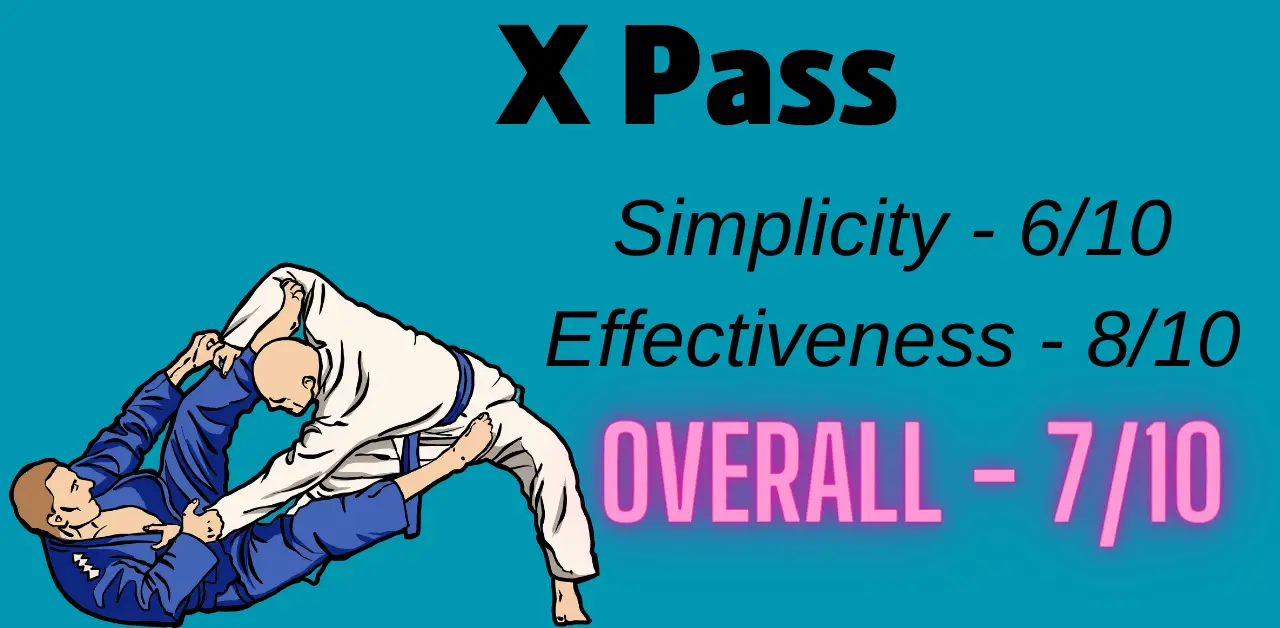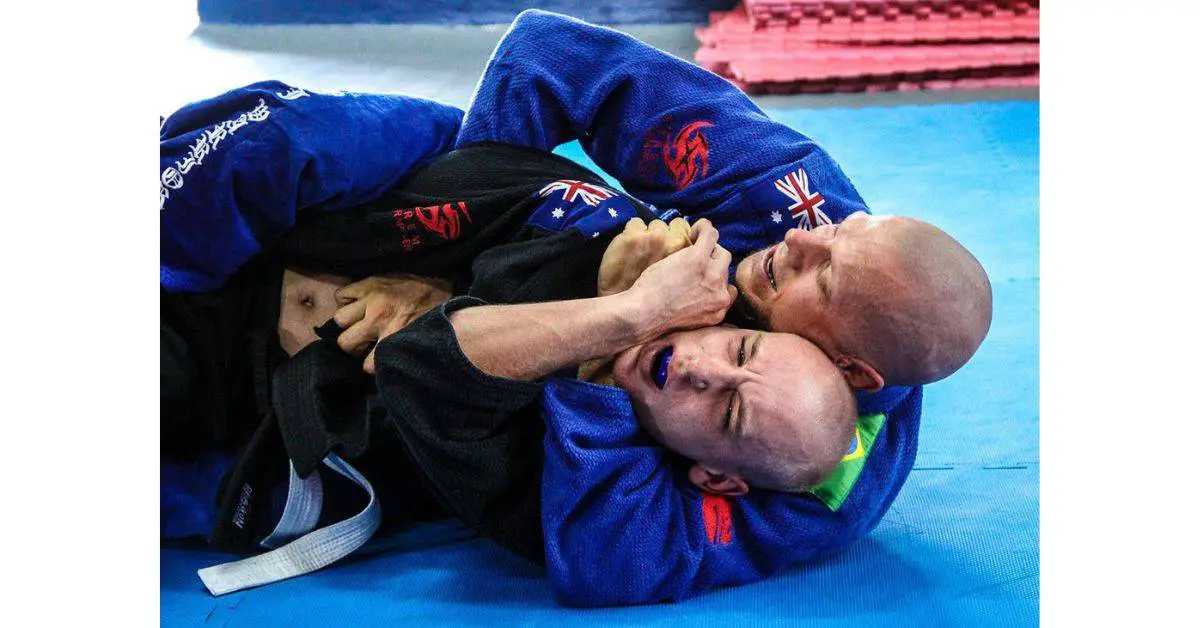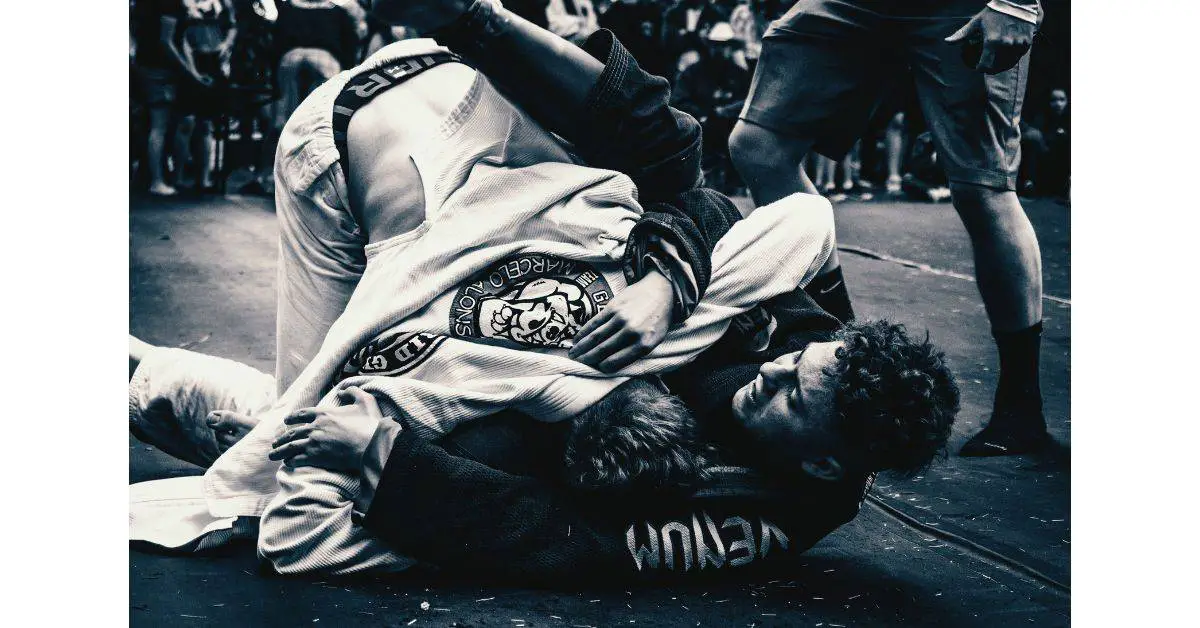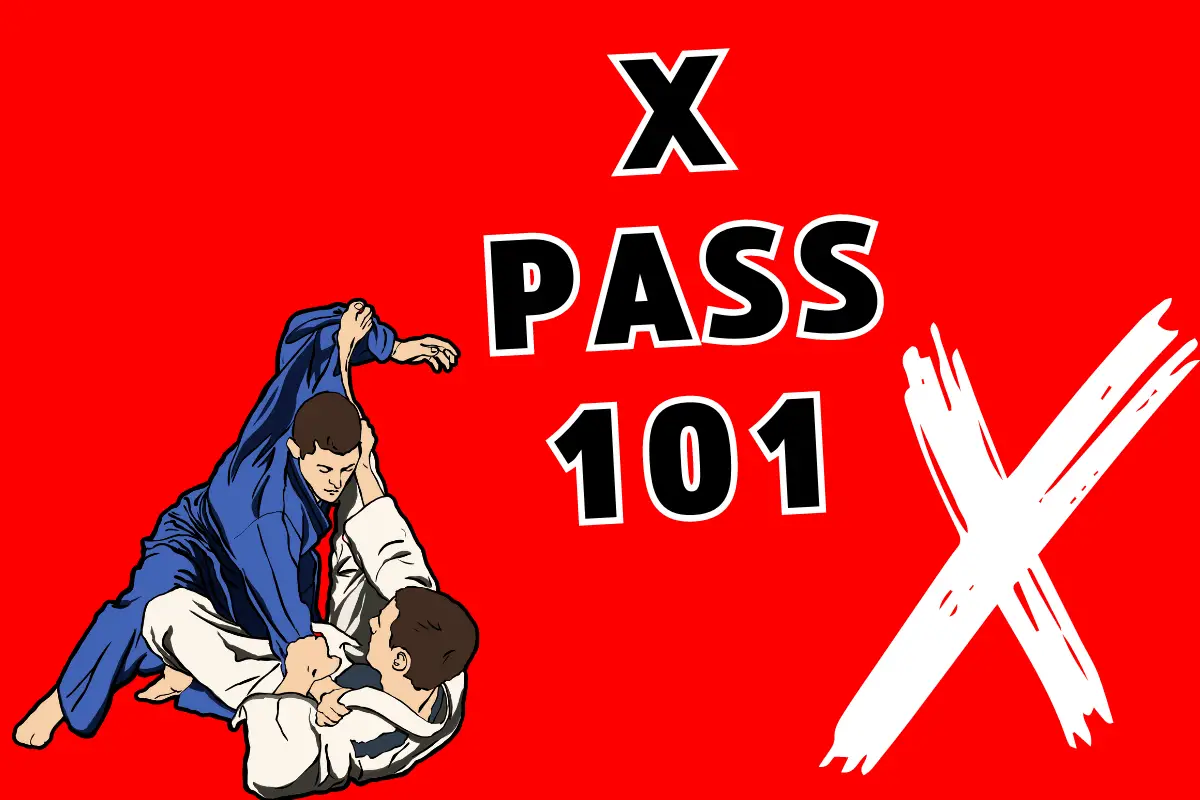The X pass in BJJ is a critical guard pass to learn and understand if you want to become an adaptive and dynamic grappler. If you have ever rolled before or been in a street fight, you know the importance of learning more techniques. The more you know, the less expected you’ll be. So, here’s how you perform the X pass:
The X pass is a guard pass you start by standing. Then, you want to put one hand on the opponent’s hip and the other on his knee. The next step will be to kick your back foot back and break his closed guard. The final step is to step forward and go for the Knee on Belly. From there, you can gain side control.
While this article won’t focus as much on how to finish the guard pass, we will briefly go over that in the future. Thus, I highly recommend you stick around until the end of this article to ensure you perfect your X pass while learning the advanced tricks.
Nonetheless, most white and even blue belts will make the same mistakes when they first learn this guard pass. You need to understand that fixing these mistakes will take minimal effort. But many grapplers don’t bother working on them.
As a result, they’ll form bad habits throughout their game. My goal with this guide is to help you avoid as many of these mistakes as possible.
If you were to watch a single YouTube video and practice yourself, you would make these mistakes repeatedly. That’s why I recommend reading the article chronologically so you won’t miss any critical details.
And, if you want to learn another critical pass after reading this guide, click the link to learn everything about the Toreando pass and why it’s perhaps the most important guard pass in BJJ.
Now, let’s dive in!

How to perform the X pass
This part of the article will break down the steps so you can begin to learn and understand this beautiful guard pass. Eventually, there’s nothing more fulfilling in Jiu-Jitsu than passing the opponent’s guard and finishing the fight with an aggressive submission.
I know many grapplers reading this article might find it challenging to finish their move, so if you want to learn about the most effective BJJ submissions and how to perform each perfectly, follow the link to an article I wrote on the topic!
Now, let’s dive into the individual steps. I encourage you to read each carefully to fully understand the importance of each step and how you can start working on them today!
Step #1 – Gain inside control
The first step will be to gain side control. If the opponent has a solid butterfly guard on you, this might be one of the most difficult ones (surprising, I know!).
You want to gain inside control. Now, how do you do that? First, you apply pressure from your knee to the opponent’s ankles. This will force him to give up his butterfly guard. Then, you can step above his leg and begin to set up this guard pass.
Now, it’s important to mention that this step only applies if the opponent has a solid grasp of the butterfly guard and he applies it on you.
Once you’re inside his legs, move on to the second step.
Learn to perform the Stack Pass, BJJ’s most effective guard pass, flawlessly by following the link.
Step #2 – Wait for the opponent to sit up and push him backward
The second step is beneficial but not mandatory. It’s only compulsory if you want to surprise the opponent with this quick guard pass.
If the opponent sits up and tries to grab you or go for any other move, you push him back and start the X pass immediately after. That will give you the advantage, as he will be misaligned, and you’ll have complete control over the fight.
That’s it for this step. Make sure not to lean forward as much when you push him backward. You want to maintain a balanced posture before moving to the 3rd step.
Before moving on, follow the link to learn how to perform the Leg Drag pass, one of BJJ’s most effective and simple guard passes.
Step #3 – Grab his hip and knee
The 3rd step is the first action step. Once you push him backward, you want to grab his hip and knee. If you do that, you’ll have more control over the opponent, allowing you the advantage.
Nonetheless, you always want to have a grip over your opponent, especially when going for a guard pass, to ensure he can’t maneuver back to you.
Hip and leg control are critical to executing the X pass flawlessly. You don’t want to allow the opponent the ability to return to you and start working from his guard. Instead, you want to keep as much control as possible to ensure he cannot evade your guard pass.
Once you push him backward, you want to grab his knee and hip; this is a critical step. Once you do that, you can continue with the 4th step.
However, make sure to maintain a balanced posture and not over-lean forward. If you put all your weight forward, the opponent will use that and force you to fall on him, leaving you more vulnerable than ever. Make sure to have a solid basis.
Follow the link to learn to flawlessly perform the Knee Slice pass in BJJ.
Step #4 – Kick your foot back, breaking his guard
This step is perhaps what makes the X pass so effective. Now that you have a firm grip on his knee and hip, you can start to advance with the guard pass.
You now want to kick your inside foot back. If the opponent is in a closed guard position, this will break it and separate his legs, giving you control over the fight. However, this move is necessary even if it’s an open guard, so do not skip it.
Once you kick your foot back (it’s not too complicated), you can move on to the next step.
Step #5 – Step forward
The 5th step will be to step forward. Some coaches combine stepping forward with kicking your foot back. I’m actually a fan of this variation, as it shortens the execution time of the guard pass.
And, as we all know, you want to minimize the time the pass goes on for. The quicker and more precise the X pass, the more likely you’ll be to break the opponent’s guard.
Now, stepping forward will prepare you for the next step, going for the Knee on Belly.
You want to kick your foot back (as we’ve discussed in the previous step) and step forward. It shouldn’t be too hard and shouldn’t take a lot of time or thought. Simply step forward in a way that’s comfortable for you.
Step #6 – Go to the Knee on Belly
Now you’re ready for the finishing step of this pass. By now, you’re already past his guard. As a result, you can continue with any move you want. However, the Knee on Belly is perfect in this position, so I encourage you to try it first before trying anything else.
After you step forward, it’ll be best to immediately go for the Knee on Belly, as you can leverage this position to finish the fight quickly (as we’ll examine in the 7th step.)
By now, you’re way past the opponent’s guard. So while you can do anything you want, such as gain back-control or even go for the North-South position, the Knee on Belly to side control is your best option.
Step #7 – Finish the move (side control)
The last step of the X pass (not really a step) is to finish the move. To remind you, you’re in the Knee on Belly position and want to go for a finishing move.
While I did say in the introduction that we won’t go over finishing moves, I think it’s important to briefly discuss what you can do after you’re done with the X pass.
The best finishing move will be to go for the side control. From there, as you already know, you have countless options, such as going for the Kimura or even the Guillotine choke. Your possibilities are endless.
This is how you perform the X pass. Next, we’ll look at the best submission to go for after you’re past the opponent’s guard. (6th step)
And, if you want to learn how to perform the Cartwheel pass, another fantastic guard pass in BJJ, follow the link to become a better grappler who knows more techniques!
Best finishing submission after the X pass
Now that you’re past his guard, you want to finish the roll or match. How do you do that? Well, you can use a couple of submissions to finish the fight quickly. Let’s see which one is best to use in this position:
After transitioning to side control from the Knee on Belly and from the X pass, the best finishing submission to go for is the Kimura. The Kimura combines perfectly with this move, as you’ll have control over the opponent’s hips, arms, shoulder, and head. As a result, you’ll have space to perform it comfortably.

Of course, you can go for the Armbar, Guillotine choke, rear naked choke (if you take back control), and even the Triangle. However, I’m a big fan of the Kimura finish after the X pass because you’re already in the perfect position to perform it!
I encourage you to try multiple options and see which one you like best. Good luck!
Variations of the X pass
This section will briefly review the two variations of this magnificent guard pass, the Gi and the No-Gi. There’s really only one difference: the grip you use.
Let’s see how they differ in their grip and when you want to use each one:
Gi X pass
When performing the X pass with a Gi, you want to grab the opponent’s belt and material near the knee before kicking backward. Of course, if you compete in a tournament when grabbing the Gi is illegal, go for the No-Gi variation. But, you want to use as much as possible to gain the advantage.
And gripping the opponent’s Gi will give you a more solid grip.
No-Gi X pass
The No-Gi X pass is what we’ve discussed in this article. You want to create downward pressure on the opponent’s hip and place your palm on his knee. This will give you the most leverage and, thus, allow you to have more control when going forward for the Knee on Belly – and, later, side control.
When to use the X pass?
In short, you can use the X pass whenever you want. However, there are a few specific instances that are perfect signs of the fact that you should use it right now. Let’s see what they are.
You want to use the X pass when you’re standing up, and the opponent doesn’t have a butterfly guard on you. Likewise, you want to use it whenever you think the opponent doesn’t expect it, such as when he’s not fighting for insider leg control. That’s when you’re most likely to succeed with this guard pass.
Is the X pass effective?
The X pass is one of the most effective guards passes in BJJ, as it’s uncomplicated and will give you the advantage if you perform it correctly. This guard pass uses a kicking motion to break the opponent’s closed guard and advance forward to the Knee on Belly, granting you the side control.

Should I learn the X pass?
Learning how to pass the opponent’s guard is a critical skill in BJJ most grapplers don’t invest enough time to. Learning submissions and other fancy grappling moves will always be more enjoyable. Let’s see if this pass is even worth learning:
You should learn the X pass since it’s relatively simple and will allow you to pass many people’s guard and get into a better position, such as side control or North-South. From there, finishing the fight isn’t difficult; you’ll only need to plan your next move and go for it quickly, without hesitation.
The #1 mistake novice grapplers make is they hesitate or overthink things. The time to overthink is in practice. When you practice your BJJ skills slowly, you want to overthink every move so as to build a solid foundation for muscle memory.
However, when you go for the X pass in a roll, you want to go for it. Of course, you will make some mistakes on the way, but at least you’ll be performing it quickly, making you more likely to be successful.
So, in short, you should definitely learn the X pass in BJJ!
Final words
The X pass is one of the most essential guard passes in BJJ. Therefore, you want to learn it as your first few techniques (even as the first one) to ensure you know how to pass the opponent’s guard and gain control over the fight.
There’s nothing more fulfilling than passing the opponent’s guard and finishing the fight with an aggressive submission, such as the Kimura or Armbar.
This website is all about self-improvement and martial arts. So if you want to better yourself through martial arts, you can always go ahead and read more of my articles!
Although the X pass is highly effective, it’s not even in BJJ’s top 5 most effective guard passes. If you want to see which guard passes are the most effective in BJJ, follow the link to an article that reveals the answer.

